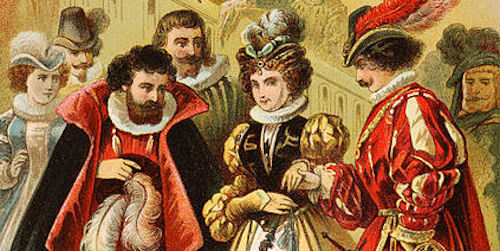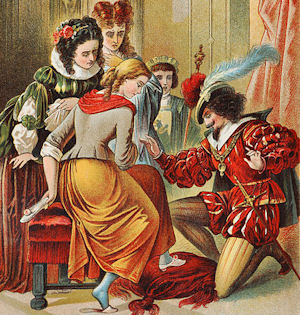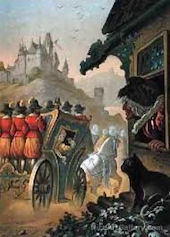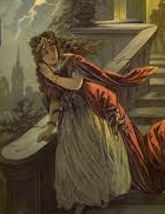
Fairy Tale and Pride and Prejudice
Trying to shoehorn Miss Austen's two-hundred-year-old Novel into
the template of the plot of what might be the world's
most famous Fairy Tale — humble Cinderella
snaring the elusive and highly sought Prince Charming —
should be both obvious, and easy. But is neither.
Other than the fact of the encounter at the ball, there
is almost no overt similarity between the two stories. (Except
in film, which throws a glaring spotlight onto the outward aspects of
Austen's plot, but is unable to reveal any part of the essential inner
meaning.) Which is not to say that Pride and
Prejudice is unlike any Fairy Tale; only
that it is not particularly similar to Cinderella.
The shoe fits!

The Novel not so well
I have discovered with dismay that no less than
three related but different and separate perspectives are required
in order to examine Pride and Prejudice in this section, and I
fervently hope that what is a fascinating investigation for me doesn't
become unalloyed drudgery for the reader/viewer of these webpages.
- 1. Fairy Tale and Pride and Prejudice,
enumerating the ways in which the Novel fits into the jigsaw list
of characteristics found in my Introduction 2A,
Fairy Tales, The Source of all Storytelling [except for Myth].
- 2. East of the Sun and West of the Moon,
a close examination of the Fairy Tale which in my opinion most closely resembles
the Novel under consideration; and
- 3. East of the Sun and West of the Moon and Pride and
Prejudice, and a direct comparison between the two.
And so to begin by enumerating the ways in which
Pride and Prejudice the Novel lines up with my system of
definitions of Fairy Tale characteristics, as mentioned above.
There has to be meaning in the fact that a Novel is still popular
two hundred years after its first publication — and what better
reason than that it shares certain essential features of a
typical Fairy Tale?
- A journey: There's no sitting
around in Fairy Tales. No doubt but
the journey into the unknown (to Netherfield, to Rosings,
and lastly to Pemberley) is distinctly fairy-tale-like.
- Aloneness: There's no
team spirit in Fairy Tales. The further we get into the
Novel, the more we become aware that Elizabeth Bennet fully shares with
her father a detachment that is innate and involuntary and a result of
the sense of irony that forms an essential part of both their
personalities. It is this detachment rather than the extreme
self-involvement of the typical Fairy Tale hero that accounts for her
solitary nature, but results in a distinct resemblance.
- Uniqueness of character:
There's no need for identity in Fairy
Tales. Perhaps
it's fair to say that Elizabeth, much like the heroine of
a Fairy Tale, is unique by virtue of her circumstances
and the detail surrounding the story. But there is
so much more, including an irrepressible sense of humour,
a devotion to her sister Jane that lends a particular
sharpness to her dealings with the censorious Mr. Darcy,
and her refusal to consider an advantageous marriage even
though the evil consequences of remaining single make her
future prospects bleak indeed. To sum up the similarity
to Fairy Tale of this particular definition, we are forced to say
maybe, maybe not.
- Resistance to change:
There's no growing up in Fairy Tales.
Like the protagonist of all Fairy Tales, Elizabeth Bennet
remains stubbornly herself throughout the course of the
Novel. Her prospects are altered at journey's end,
she is ruefully aware of previously unacknowledged
tendencies to pride and to prejudice; but her
critical faculties, her confidence, her irony and
self-deprecating sense of fun and humour, are subject to
not the slightest shred of doubt.
- Strangers along the route:
There's no lack of company on the road in Fairy
Tales. Insofar as the element of strangers along
the route is concerned, Pride and Prejudice contains
an abundance of both the helpful and hindering types. (We need
only compare the stranger who exchanged the fateful beans in Jack
and the Beanstalk with Austen's witch
[Lady Catherine de Burgh] to find a similarity of equal
parts harm and helpfulness to the hopes for future
happiness of the story's protagonist.)
- Creatures with magical powers:
There's no need for fairies in Fairy Tales.
I lied when I said that the only resemblance between
Cinderella and Pride and Prejudice
is in the meeting with Prince Charming at the ball. Because
there is a true Fairy Godmother in Pride and
Prejudice — in the person of the Bennet girls'
Aunt Gardner. And yet so well-written is Austen's novel that
Mrs. Gardner's interventions occur with utter naturalness and
inevitability, lending no hint of the magical in the
drawing out of Elizabeth's feelings toward the faithless
and mercenary Mr. Wickham, nor in the transformatory excursion to
Pemberley, nor in the clarifying letter to her cherished
niece.
- Detail: There's no
Fairy Tale without detail. Like a Fairy
Tale with its unique, unvarying and inseparable itemized store of detail,
Pride and Prejudice has its own supply of
intrinsic necessary facts. And this is where film
can provide indelible images to supplement the cool
ironic and detached tone of the Novel.
- Truthfulness: There's
no lying in Fairy Tales. Miss Austen portrays her heroine
as completely smitten with the charming newcomer Mr. Wickham, and
entirely hostile and resentful toward the brutally frank and charmless
Mr. Darcy. And yet ... As in a Fairy Tale, we wait for the details
of the story to play themselves out before making up our minds as to
truth and falsity. But with all the unexpected twists and
turns of plot, we know absolutely that although the characters may
lie, Jane Austen does not.
- Humour and Irony: There's
no irony in Fairy Tales, although there may be a great deal of
humour. I imagine no one will argue that
Pride and Prejudice contains the humour of Fairy
Tale, as well as the irony of Myth. But does this
fact lead us to a better understanding of Fairy Tale?
Of Myth? Or even of Pride and
Prejudice? I think it does, on all
counts, for reasons set forth later in these webpages.
- Innocent amorality: There's
no right and wrong in Fairy Tales.
In Pride and Prejudice,
the breathtaking scope of Mr. Darcy's arrogance is
easily the equal of any innocent amorality in Fairy Tale,
most shown in the assumption that his superior intellect,
added to money and social position, entitles him to
control the destinies of those about him. In fact
he is shown as genuinely puzzled and hurt by any
questioning of what he sees as his innate right to
tamper with the lives of others.
- Tolerance: There's
no preaching in Fairy Tales. And none in
Pride and Prejudice, either. We might
almost call the Novel a how-not-to primer on conducting
affairs of the heart.
- Subterranean Meaning:
There's no explanation in Fairy Tales.
It seems as if everything in the Novel is explained by
tale's end. But if that is indeed the case, why has this
simple story remained popular with the public for more
than two hundred years? Perhaps like the Fairy Tale it resembles,
Pride and Prejudice can be whatever the reader
believes — wishes — it to be.
* * * * *
Now to investigate the particular chosen
Fairy Tale with which to compare the Novel, and it isn't
Cinderella.
[Note that all illustrations on this page
are by the marvellous Carl Offterdinger].
[July 2007, text only
WebPage last amended
February 22nd, 2013]
________________________
-
Top of this Page
- Fairy Tale and Pride and Prejudice
-
Main Page – Index
- Main Page – Index
-
HomePage-2
- HomePage-2
Fairy Tale and Myth
-
Previous Page
- Introduction 2B:—
Myth
-
Next Page
- East of the Sun and West of the Moon





